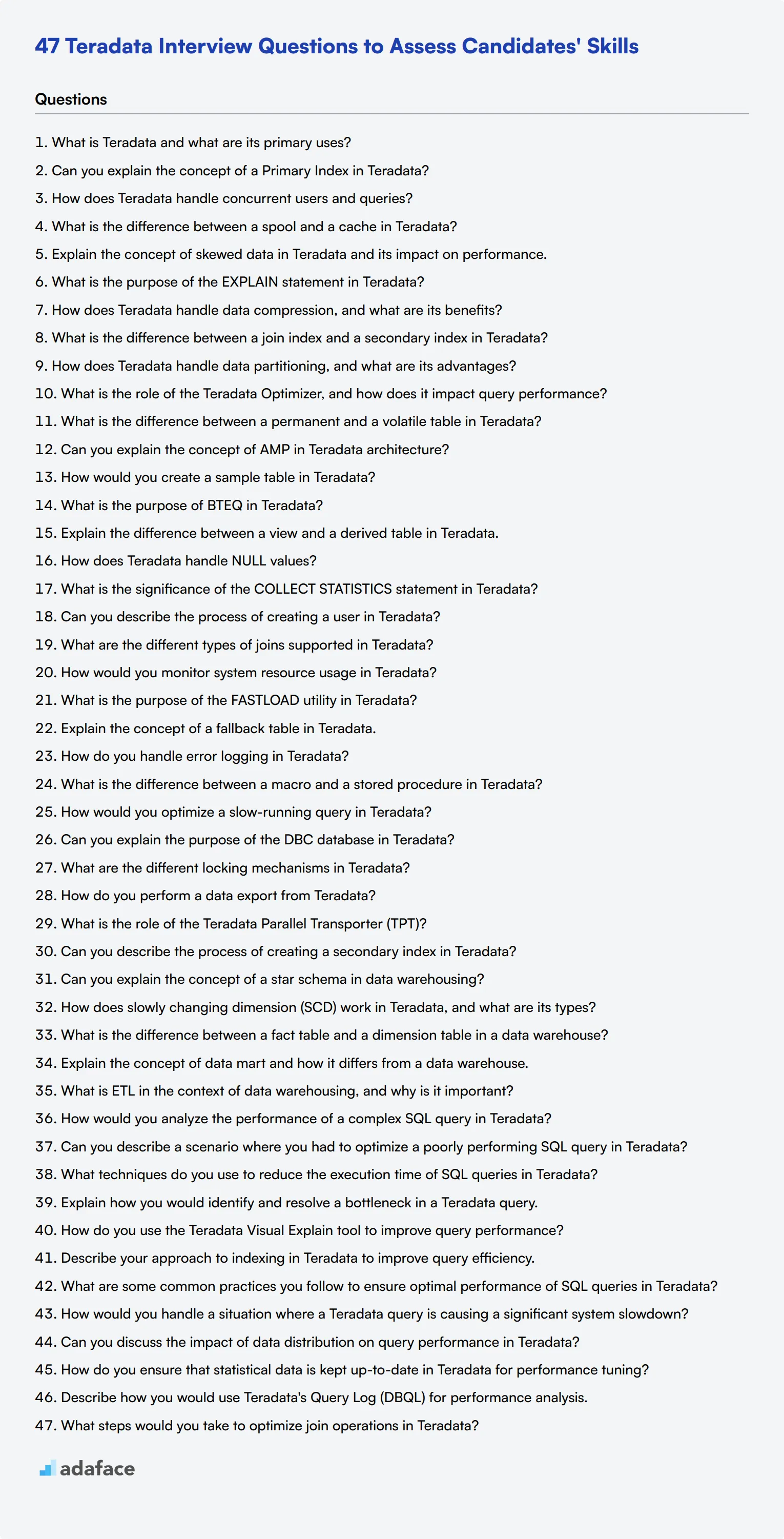Finding the right Teradata professional for your team can be challenging when you don’t have the right questions to ask. This post provides a comprehensive set of interview questions that will help you identify the skills and knowledge of potential candidates.
In this guide, we have categorized questions into four sections, covering basic queries, junior administrator roles, data warehousing concepts, and SQL performance tuning. Each section includes targeted questions and the corresponding answers to help you understand what to look for in candidates.
Using these questions, you can effectively assess and compare applicants' proficiency in Teradata. For an enhanced pre-interview screening process, consider using our Teradata online test.
Table of contents
10 basic Teradata interview questions and answers to assess candidates
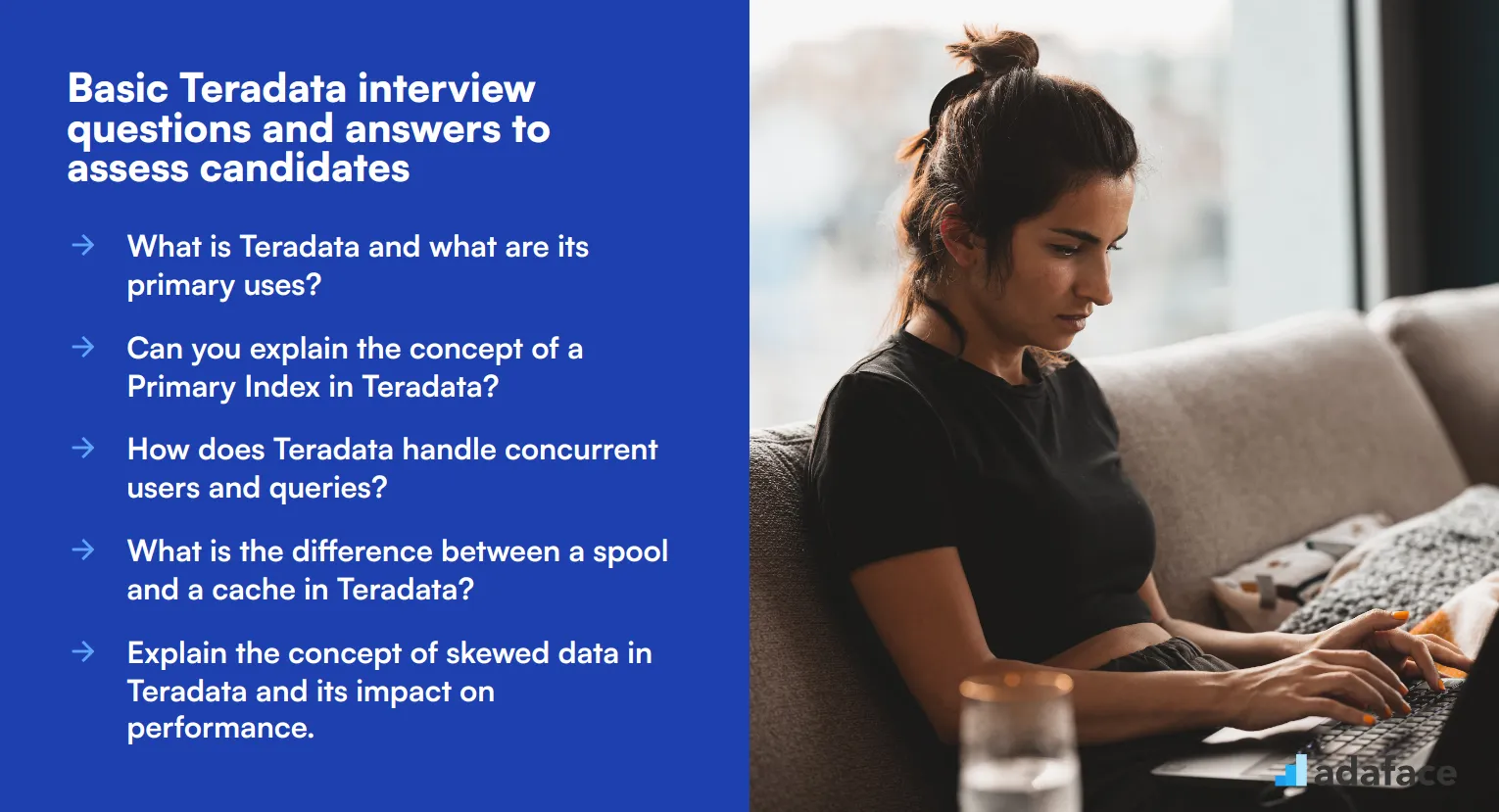
Navigating the intricate world of Teradata interviews can be as tricky as finding a needle in a data haystack. These 10 basic Teradata interview questions are designed to help recruiters and hiring managers assess candidates' foundational knowledge and problem-solving skills. Use them as a starting point to gauge a candidate's understanding of Teradata concepts and their ability to apply them in real-world scenarios.
1. What is Teradata and what are its primary uses?
Teradata is a relational database management system (RDBMS) designed for large-scale data warehousing and big data analytics. Its primary uses include:
- Enterprise data warehousing
- Business intelligence
- Big data analytics
- Advanced analytics and data mining
- Real-time operational analytics
Look for candidates who can explain Teradata's role in handling large volumes of data and its ability to perform complex queries efficiently. Strong answers will highlight Teradata's scalability and parallel processing capabilities, which are crucial for data analysts and scientists working with massive datasets.
2. Can you explain the concept of a Primary Index in Teradata?
A Primary Index (PI) in Teradata is a mechanism used to distribute data evenly across all AMPs (Access Module Processors) in the system. It's not the same as a primary key, although they can sometimes coincide. The Primary Index is defined when creating a table and determines how data is distributed and accessed.
Key points about Primary Index:
- It's used for data distribution, not for ensuring uniqueness
- It affects query performance significantly
- It can be unique (UPI) or non-unique (NUPI)
Ideal candidates should be able to explain the importance of choosing an appropriate Primary Index for optimal performance. They might also mention that a well-chosen PI can reduce data movement during joins and aggregations, leading to faster query execution.
3. How does Teradata handle concurrent users and queries?
Teradata manages concurrent users and queries through its Parallel Database Architecture and workload management features. Key aspects include:
- Parallel processing: Queries are broken down and processed simultaneously across multiple AMPs
- Workload management: Teradata Active System Management (TASM) prioritizes and allocates resources to different workloads
- Query scheduling: The Teradata Optimizer determines the most efficient execution plan for each query
Look for candidates who understand the importance of workload management in a multi-user environment. They should be able to discuss how Teradata balances resource allocation to ensure critical queries are not starved of resources while maintaining overall system performance.
4. What is the difference between a spool and a cache in Teradata?
In Teradata, both spool and cache are temporary storage mechanisms, but they serve different purposes:
Spool:
- Temporary workspace for query processing
- Stores intermediate results during query execution
- Managed by the Teradata database engine
Cache:
- Stores frequently accessed data
- Aims to reduce I/O operations and improve query performance
- Can be at various levels (e.g., database cache, file system cache)
A strong candidate should be able to explain how spools are essential for complex query processing, while caches help improve overall system performance by reducing disk I/O. They might also mention that effective cache management is crucial for optimizing Teradata performance, especially in environments with repetitive query patterns.
5. Explain the concept of skewed data in Teradata and its impact on performance.
Skewed data in Teradata refers to an uneven distribution of data across the AMPs (Access Module Processors). This occurs when the chosen Primary Index results in a disproportionate amount of data being stored on one or a few AMPs, while others remain underutilized.
Impact on performance:
- Increased response time for queries
- Uneven resource utilization
- Potential bottlenecks in data processing
- Reduced overall system efficiency
Look for candidates who can explain strategies to mitigate data skew, such as choosing an appropriate Primary Index, using secondary indexes, or implementing data partitioning. They should understand that addressing data skew is crucial for maintaining optimal database performance in Teradata systems.
6. What is the purpose of the EXPLAIN statement in Teradata?
The EXPLAIN statement in Teradata is a powerful tool used to analyze and optimize query performance. Its main purposes include:
- Displaying the execution plan for a given SQL query
- Showing estimated processing time and resource usage
- Identifying potential performance bottlenecks
- Providing insights into how the Teradata Optimizer interprets and executes the query
A strong candidate should be able to discuss how they use the EXPLAIN statement to troubleshoot slow queries and optimize performance. They might mention looking at factors like step counts, spool usage, and AMP distribution to identify areas for improvement in query design or table structure.
7. How does Teradata handle data compression, and what are its benefits?
Teradata employs various data compression techniques to reduce storage requirements and improve query performance. Some key aspects of Teradata's compression include:
- Block-level compression: Compresses data within each data block
- Multi-value compression: Efficiently stores repeated values
- Algorithmic compression: Uses algorithms to compress specific data types
Benefits of data compression in Teradata:
- Reduced storage costs
- Improved I/O performance
- Faster data transfer between storage and memory
- Enhanced query performance due to reduced data volume
Look for candidates who understand the trade-offs between compression ratios and CPU usage. They should be able to discuss scenarios where compression is most beneficial and how it impacts overall system performance.
8. What is the difference between a join index and a secondary index in Teradata?
Join indexes and secondary indexes in Teradata are both used to improve query performance, but they serve different purposes:
Join Index:
- Precomputes and stores join results
- Useful for frequently performed joins
- Can significantly reduce query execution time for complex joins
Secondary Index:
- Provides an alternative access path to data
- Improves performance for queries that don't use the Primary Index
- Helps in retrieving specific rows quickly
A strong candidate should be able to explain when to use each type of index. They might discuss how join indexes can dramatically improve performance for complex, frequently-run queries, while secondary indexes are more versatile for improving access to data based on non-primary index columns. Understanding these indexing strategies is crucial for optimizing Teradata performance.
9. How does Teradata handle data partitioning, and what are its advantages?
Teradata supports data partitioning through its Partitioned Primary Index (PPI) feature. This allows large tables to be divided into smaller, more manageable pieces based on specified criteria. Key aspects of Teradata partitioning include:
- Row-based partitioning: Data is divided based on column values
- Automatic partition elimination: Teradata can skip irrelevant partitions during query execution
- Multi-level partitioning: Tables can be partitioned using multiple columns
Advantages of partitioning:
- Improved query performance through partition elimination
- Easier data management and maintenance
- Enhanced data loading and archiving processes
- Better support for time-based queries and historical data analysis
Look for candidates who can explain how partitioning strategies should align with common query patterns and business requirements. They should understand that effective partitioning can significantly improve query performance and data management in large-scale Teradata environments.
10. What is the role of the Teradata Optimizer, and how does it impact query performance?
The Teradata Optimizer is a critical component of the database engine responsible for determining the most efficient way to execute SQL queries. Its primary functions include:
- Analyzing SQL statements
- Evaluating possible execution plans
- Estimating costs for each plan
- Selecting the optimal execution strategy
Impact on query performance:
- Chooses the most efficient join methods and order
- Determines when to use indexes
- Decides on data access paths
- Optimizes resource utilization
A strong candidate should understand that the Optimizer's decisions significantly influence query performance. They might discuss the importance of keeping statistics up-to-date and how query rewrites can sometimes help the Optimizer make better decisions. Knowledge of Optimizer behavior is crucial for database developers working with Teradata systems.
20 Teradata interview questions to ask junior database administrators
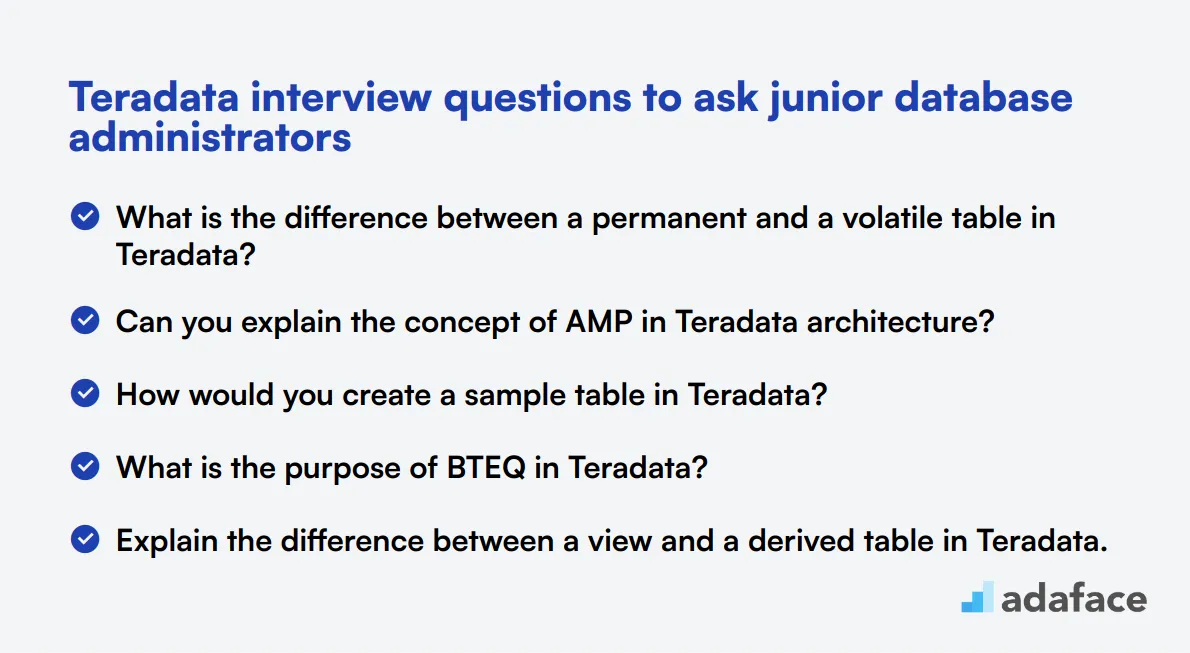
When interviewing junior database administrators for Teradata roles, it's crucial to assess their foundational knowledge and practical skills. Use these 20 questions to evaluate candidates' understanding of Teradata basics, data management capabilities, and problem-solving abilities in a database environment.
- What is the difference between a permanent and a volatile table in Teradata?
- Can you explain the concept of AMP in Teradata architecture?
- How would you create a sample table in Teradata?
- What is the purpose of BTEQ in Teradata?
- Explain the difference between a view and a derived table in Teradata.
- How does Teradata handle NULL values?
- What is the significance of the COLLECT STATISTICS statement in Teradata?
- Can you describe the process of creating a user in Teradata?
- What are the different types of joins supported in Teradata?
- How would you monitor system resource usage in Teradata?
- What is the purpose of the FASTLOAD utility in Teradata?
- Explain the concept of a fallback table in Teradata.
- How do you handle error logging in Teradata?
- What is the difference between a macro and a stored procedure in Teradata?
- How would you optimize a slow-running query in Teradata?
- Can you explain the purpose of the DBC database in Teradata?
- What are the different locking mechanisms in Teradata?
- How do you perform a data export from Teradata?
- What is the role of the Teradata Parallel Transporter (TPT)?
- Can you describe the process of creating a secondary index in Teradata?
5 Teradata interview questions and answers related to data warehousing concepts
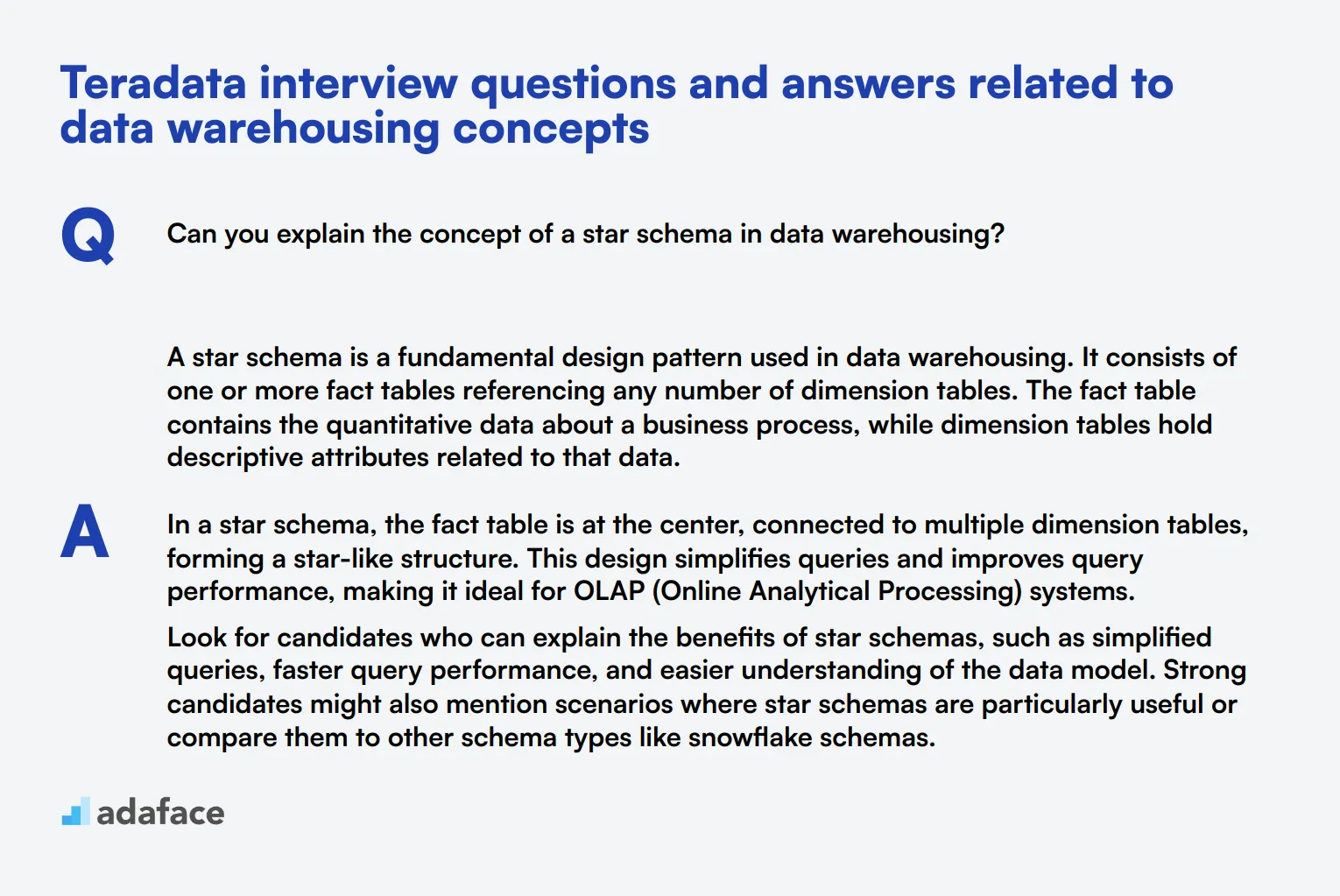
Ready to dive into the data warehouse? These Teradata interview questions will help you assess candidates' understanding of key data warehousing concepts. Use them to gauge how well applicants can navigate the intricate world of data analytics and warehousing. Remember, the best candidates will not only know the answers but also understand the 'why' behind them.
1. Can you explain the concept of a star schema in data warehousing?
A star schema is a fundamental design pattern used in data warehousing. It consists of one or more fact tables referencing any number of dimension tables. The fact table contains the quantitative data about a business process, while dimension tables hold descriptive attributes related to that data.
In a star schema, the fact table is at the center, connected to multiple dimension tables, forming a star-like structure. This design simplifies queries and improves query performance, making it ideal for OLAP (Online Analytical Processing) systems.
Look for candidates who can explain the benefits of star schemas, such as simplified queries, faster query performance, and easier understanding of the data model. Strong candidates might also mention scenarios where star schemas are particularly useful or compare them to other schema types like snowflake schemas.
2. How does slowly changing dimension (SCD) work in Teradata, and what are its types?
Slowly Changing Dimension (SCD) is a concept in data warehousing used to handle gradual changes in dimension data over time. In Teradata, SCDs are implemented to track historical changes in dimension attributes. There are several types of SCDs, with the most common being Type 1, Type 2, and Type 3.
- Type 1 SCD: Overwrites the old value with the new value, not maintaining any history.
- Type 2 SCD: Creates a new record for each change, maintaining full history.
- Type 3 SCD: Adds a new column to store the previous value, maintaining limited history.
An ideal candidate should be able to explain these types and discuss their pros and cons. Look for understanding of when to use each type based on business requirements. Follow up by asking about their experience implementing SCDs in real-world scenarios.
3. What is the difference between a fact table and a dimension table in a data warehouse?
In a data warehouse, fact tables and dimension tables serve different purposes:
- Fact tables: Contain quantitative data about business processes (e.g., sales amounts, quantities). They typically have foreign keys to dimension tables and numerical measures.
- Dimension tables: Contain descriptive attributes used to analyze the data in fact tables (e.g., product details, customer information, time periods).
Fact tables are usually much larger than dimension tables and are optimized for aggregations and calculations. Dimension tables, on the other hand, are used for filtering, grouping, and labeling in reports and analyses.
Look for candidates who can clearly articulate the differences and provide examples. Strong candidates might also discuss how these tables interact in queries and explain concepts like data modeling in the context of fact and dimension tables.
4. Explain the concept of data mart and how it differs from a data warehouse.
A data mart is a subset of a data warehouse that focuses on a specific business line, department, or subject area. It's designed to meet the specific reporting and analytical needs of a particular group of users. Data marts are smaller, more focused, and often easier to manage than full-scale data warehouses.
Key differences between data marts and data warehouses:
- Scope: Data marts cover specific subject areas, while data warehouses encompass the entire organization.
- Size: Data marts are typically smaller and more agile.
- Users: Data marts cater to specific departments or user groups, while data warehouses serve the entire organization.
- Implementation time: Data marts can be implemented faster due to their limited scope.
Evaluate candidates based on their understanding of when to use data marts versus full data warehouses. Strong candidates might discuss the concept of dependent and independent data marts, and how they fit into an overall data strategy.
5. What is ETL in the context of data warehousing, and why is it important?
ETL stands for Extract, Transform, Load. It's a crucial process in data warehousing that involves:
- Extracting data from various source systems
- Transforming the data (cleaning, reformatting, applying business rules)
- Loading the processed data into the target data warehouse
ETL is important because it ensures that data in the warehouse is consistent, accurate, and useful for analysis. It helps in integrating data from disparate sources, improving data quality, and structuring data to support business intelligence and analytics.
Look for candidates who can explain each step of the ETL process and its significance. Strong candidates might discuss challenges in ETL processes, tools they've used, or strategies for optimizing ETL performance. Consider asking about their experience with real-world ETL scenarios or how they've handled data quality issues during the ETL process.
12 Teradata questions related to SQL queries and performance tuning
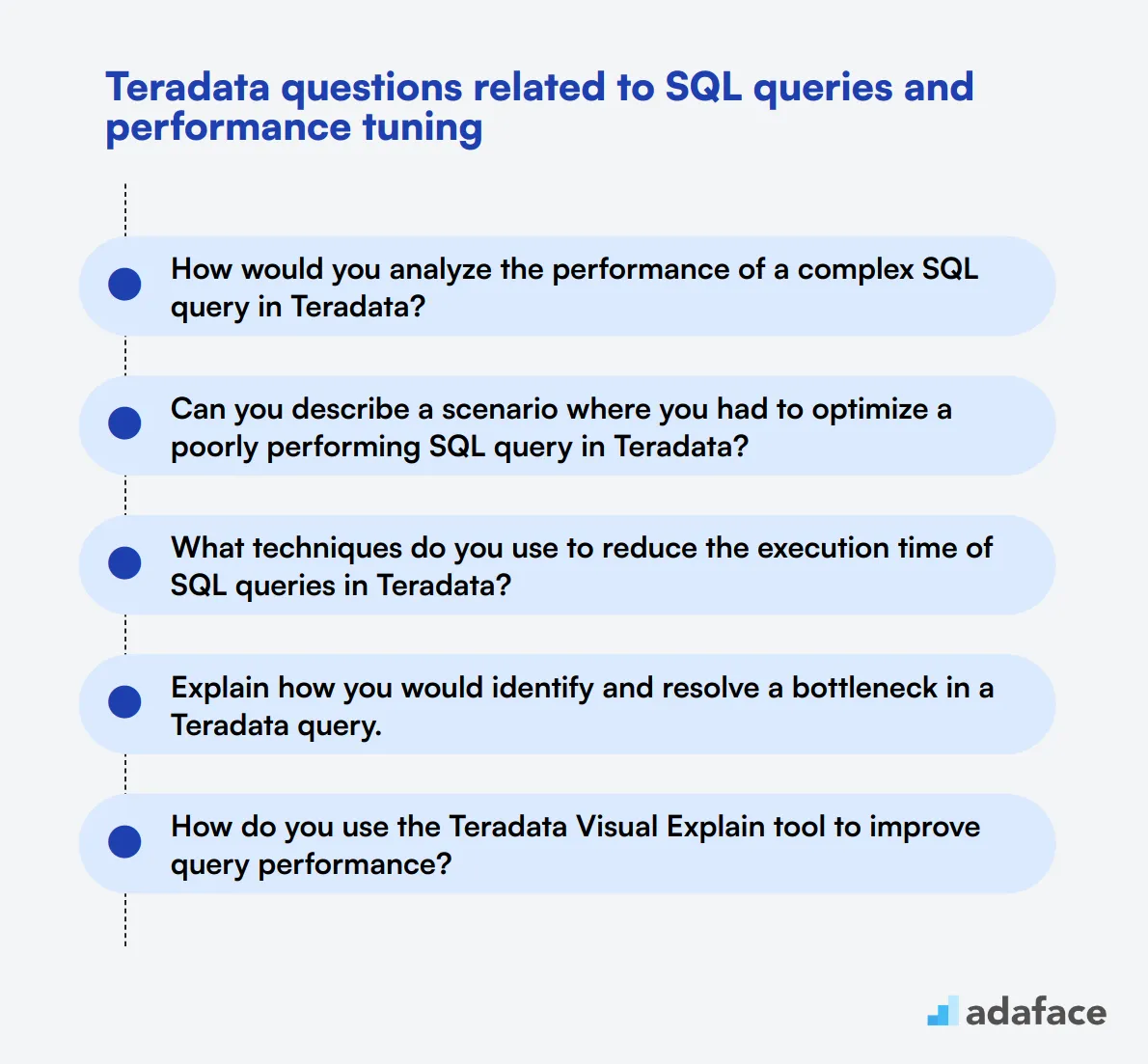
To ensure your candidates have the right technical skills and knowledge to optimize SQL queries and enhance performance in Teradata, consider using some of these targeted interview questions. This list is designed to help recruiters and hiring managers assess the depth of an applicant's understanding in a straightforward manner.
- How would you analyze the performance of a complex SQL query in Teradata?
- Can you describe a scenario where you had to optimize a poorly performing SQL query in Teradata?
- What techniques do you use to reduce the execution time of SQL queries in Teradata?
- Explain how you would identify and resolve a bottleneck in a Teradata query.
- How do you use the Teradata Visual Explain tool to improve query performance?
- Describe your approach to indexing in Teradata to improve query efficiency.
- What are some common practices you follow to ensure optimal performance of SQL queries in Teradata?
- How would you handle a situation where a Teradata query is causing a significant system slowdown?
- Can you discuss the impact of data distribution on query performance in Teradata?
- How do you ensure that statistical data is kept up-to-date in Teradata for performance tuning?
- Describe how you would use Teradata's Query Log (DBQL) for performance analysis.
- What steps would you take to optimize join operations in Teradata?
Which Teradata skills should you evaluate during the interview phase?
Assessing a candidate's Teradata skills in a single interview can be a challenging task. However, focusing on key skills during the interview phase can provide valuable insights into their capabilities and potential fit for your organization. Here are the core skills you should evaluate.
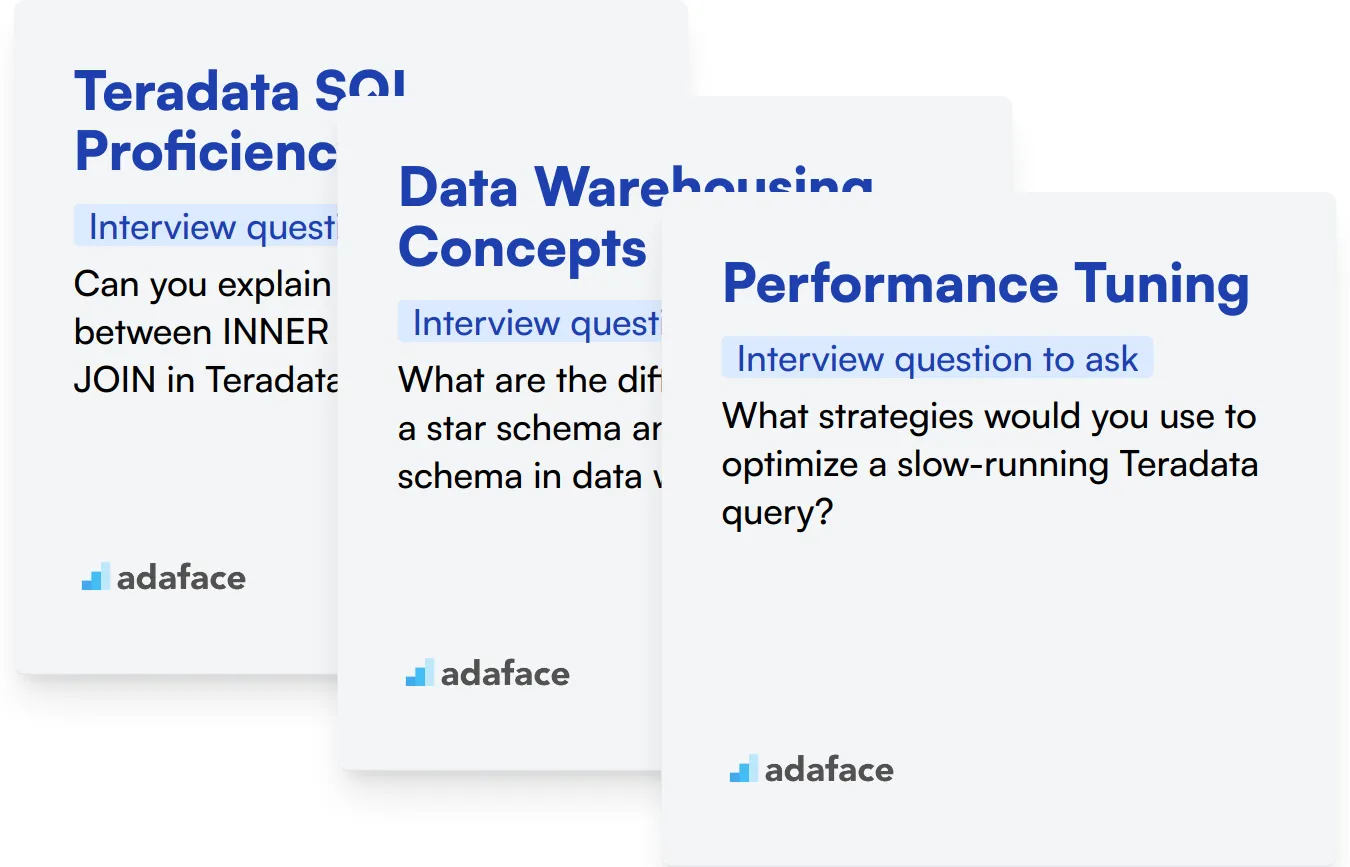
Teradata SQL Proficiency
To gauge SQL proficiency, consider using an assessment test that includes relevant multiple-choice questions. This can help filter candidates based on their SQL expertise. Check out our Teradata SQL Test to find suitable questions.
Additionally, you can ask targeted interview questions to further assess this skill.
Can you explain the difference between INNER JOIN and LEFT JOIN in Teradata SQL?
When asking this question, look for a clear understanding of joins and their impact on query results. A strong candidate should articulate the differences clearly and provide examples of when to use each join effectively.
Data Warehousing Concepts
You can utilize assessment tests that include multiple-choice questions on data warehousing principles to evaluate this skill accurately.
Furthermore, consider asking questions that target their knowledge in this area.
What are the differences between a star schema and a snowflake schema in data warehousing?
When this question is posed, assess their ability to differentiate the two schemas and understand the advantages and disadvantages of each. Strong candidates should provide context for their choices based on specific use cases.
Performance Tuning
Using a targeted assessment test with relevant MCQs can help you evaluate a candidate's performance tuning skills in Teradata.
You may also opt for specific interview questions to explore this competency further.
What strategies would you use to optimize a slow-running Teradata query?
When asking this question, look for a detailed response that includes techniques, such as indexing, rewriting queries, or analyzing execution plans. Their answer should reflect a systematic approach to performance enhancement.
3 Tips for Using Teradata Interview Questions
Before putting what you've learned to use, here are our tips for effectively utilizing Teradata interview questions.
1. Implement Skills Tests Before Interviews
Using skills tests before interviewing can help you filter out unqualified candidates early in the process. This ensures that the candidates you spend time interviewing have the foundational knowledge required for the role.
Consider using targeted tests from Adaface's library, such as the Teradata Online Test for Teradata-specific skills, or the Data Warehousing Online Test to assess their understanding of data warehousing concepts.
These tests can streamline your hiring process by identifying capable candidates quickly, allowing you to focus your interview time on those who have already demonstrated a competence in key areas.
2. Compile Relevant Interview Questions
Time is limited in interviews, so it's important to ask a concise set of relevant questions to maximize the evaluation process. Focus on questions that cover the most critical aspects of the role.
Consider incorporating questions from other related domains to get a comprehensive view of the candidate's capabilities. For example, you might include questions from our SQL Server interview questions or data modeling interview questions.
3. Incorporate Follow-Up Questions
Simply asking your set of interview questions might not be enough. Follow-up questions can reveal deeper insights and verify the candidate’s expertise.
For instance, if you ask about a candidate's experience with Teradata, a good follow-up might be: 'Can you give an example of a complex query you optimized and the steps you took?' This helps you gauge their problem-solving skills and depth of knowledge.
Streamline Your Hiring with Accurate Teradata Skill Assessment
When hiring for roles requiring Teradata expertise, it's important to verify candidates' skills accurately. The most straightforward way to assess these skills is through specialized skill tests. Consider using our Teradata Online Test to evaluate candidates effectively.
After utilizing our skill tests, you'll be better equipped to shortlist the top candidates for interviews. To further streamline your hiring process, sign up at our dashboard, where you can manage assessments and review candidate scores efficiently.
Teradata Online Test
Download Teradata interview questions template in multiple formats
Teradata Interview Questions FAQs
Focus on database administration, SQL queries, data warehousing concepts, and performance tuning skills during a Teradata interview.
The number of questions depends on the interview duration and depth. Our guide provides 50 questions across various skill levels and topics.
Yes, the questions are categorized for different experience levels, from basic concepts to advanced topics suitable for senior roles.
Use a mix of technical and practical questions, listen for detailed explanations, and assess problem-solving skills alongside technical knowledge.

40 min skill tests.
No trick questions.
Accurate shortlisting.
We make it easy for you to find the best candidates in your pipeline with a 40 min skills test.
Try for freeRelated posts
Free resources




